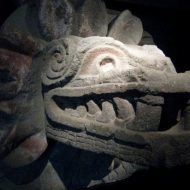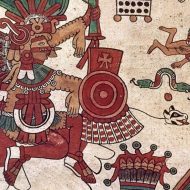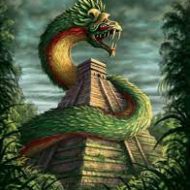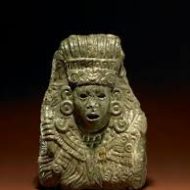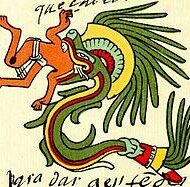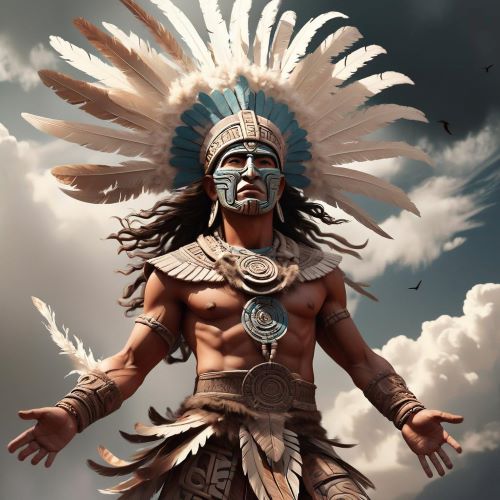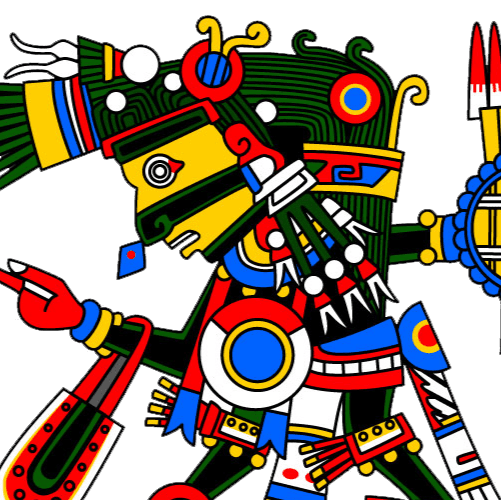Quetzalcoatl : The Feathered Serpent
Listen
At a glance
| Description | |
|---|---|
| Origin | Aztec Mythology |
| Classification | Gods |
| Family Members | Coatlicue (Mother), Onteol (Father), Mixcoatl (Father), Ometecuhtli (Mother), Omecihuatl (Father), Huitzilopochtli (Brother), Xipe Totec (Brother), Tezcatlipoca (Son) |
| Region | Mexico |
| Associated With | Creation, Wisdom, Education, Knowledge, Calendars, Astronomy |
Quetzalcoatl
Introduction
The name of the deity Quetzalcoatl comes from the Nahuatl language, and it means “Precious Serpent,” which is a reference to the serpent that is associated with the god. Quetzalcoatl was a prominent deity in the Aztec pantheon, as he was related to various phenomenon such as the planet Venus, the wind, and the sun and was also the patron of the Aztec priesthood. Aside from these, he was also associated with other gods such as Tlaloc, Huitzilopochtli, and Tezcatlipoca.
In ancient Mesoamerica, Quetzalcoatl was one of the most important gods. He was known for his role in the creation of the world and its inhabitants. His name combines the Nahuatl words coatl and quetzal. From 1200, Quetzalcoatl was regarded as the patron deity of merchants and priests in Central Mexico. He was also known for inventing the calendar and was associated with various animals, such as the opossum and also the Morning Star Venus. He also discovered a mountain full of seeds and grains.
Following the arrival of Nahua-speaking tribes in the north, Quetzalcoatl’s cult underwent significant changes. During the Toltec era, his temple was the centre of ceremonial life in the city of Tula and the culture emphasises war and human sacrifice.
Physical Traits
Aside from being a plumed serpent, Quetzalcoatl was also known as a man with a beard. He was depicted as Ehécatl, the wind god, and he wore a conical hat and a mask made out of tubes.
Quetzalcoatl was also known to have a flower, a black and yellow feathered fan, jade earnings and spiral shells inside a hat-band holding sacrificial implements. He was also known to wear a cross section of a pectoral that was made from a conch whorl which was in fact a wind jewel called Ehecailacozcatl. He is often black, wears a red mask like a duck’s beak and has long canine teeth. As a god of the cardinal directions, he was associated with various colours representing each of the directions.
Family
There are various stories about the life and times of the serpent. In one story, a virgin named Chimalman is said to have given birth to Quetzalcoatl after the god Onteol appeared to her in a dream. In another story, Chimalman conceived Quetzalcoatl after she swallowed an emerald. In another story, a man named Mixcoatl accidently shot an arrow into her womb and nine months later, Chimalman gave birth to a child who would later be called Quetzalcoatl. One of the stories states that Quetzalcoatl was the child of the god Coatlicue, who had hundreds of children.
According to another version of the myth, Quetzalcoatl is one of the four sons of Ometecuhtli and Omecihuatl. The four Tezcatlipocas, each of whom presides over one of the four cardinal directions are White Tezcatlipoca (Quetzalcoatl), Blue Tezcatlipoca (Huitzilopochtli), Red Tezcatlipoca (Xipe Totec) and Black Tezcatlipoca (Tezcatlipoca). It is also suggested that he was a son of Xochiquetzal and Mixcoatl.
Other Names
He was known as Kukulkán to the Maya, Gucumatz to the Quiché of Guatemala, and Ehecatl to the Gulf Coast Huastecs.
Powers and Abilities
Quetzalcoatl was regarded as the patron deity of merchants, priests, and scientists. In the Nahua tradition, he is also the creator of the universe and the creator of humanity. Quetzalcatl was regarded as the creator of the calendar and books as well as the protector of goldsmiths and other craftsmen. He was said to have gone to Mictlan with Xolotl to obtain the remains of the dead and was also the symbol of death and destruction. Those bones he anointed with his own blood, giving birth to the men who inhabit the present universe.
In an alternative form of creation, Quetzalcoatl and Tezcatlipoca worked together to form the first man, the rain gods, and the sun. When they were created, they transformed into snakes and ripped apart a reptilian creature known as Cipactli.
Modern Day Influence
Over the years, Quetzalcoatl has been represented various times in media like video games, manga, anime, comics and in television. The official airline of Mexico also has a special plane depicting the god on the exterior.
Related Images
Frequently Asked Questions
What is Quetzalcoatl the god of?
The feathered serpent god Quetzalcoatl wasn’t confined to just one domain, he soared through the air as the god of wind, shaped the world as a creator, nurtured life with rain and knowledge, brought order as a wise ruler, and shone as a beacon of hope with his celestial ties, embodying a vibrant tapestry of creation, virtue, and the very breath of life itself.
Is Quetzalcoatl a male or female?
Quetzalcoatl’s gender, like his essence, is multifaceted. While he’s usually seen as male, with masculine imagery and connections, hints of androgyny and flexible cultural conceptions of gender make him a figure who transcends simple categorization, embodying the complex and fluid nature of the divine in Mesoamerican belief.
What killed Quetzalcoatl?
Quetzalcoatl, instead of succumbing to the cold embrace of death, embarked on journeys of epic proportions. He sailed away on serpent rafts, transformed into celestial bodies, and even merged with other divine forces, his essence never truly extinguished, but rather shifting and evolving like the cycles of creation and the stars above.
Who is Quetzalcoatl's brother?
Quetzalcoatl’s family tree blossoms with brothers: the enigmatic Tezcatlipoca, fiery Xolotl, warrior Huitzilopochtli, and bountiful Xipe Totec. Each adds a unique branch to his divine tapestry, weaving tales of rivalry, loyalty, creation, and abundance, proving that Quetzalcoatl’s story stretches far beyond a single fraternal bond.
Is Quetzalcoatl a dragon god?
Quetzalcoatl may sport scales and soar like a serpent, but he’s no fire-breathing dragon. Born in the winds of Mesoamerican myth, he embodies creation, knowledge, and hope, far exceeding the typical dragon’s fiery ferocity. While they share a scaly kinship, their roles and origins diverge, making Quetzalcoatl a divine figure unique to the vibrant tapestries of ancient Mesoamerica.

